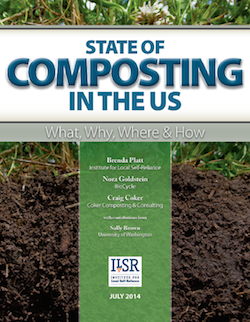Composting is a proven approach to reduce waste and build soil health and fertility. Amending soil with compost improves its quality and structure and thus its ability to withstand the impacts of extreme weather, from severe droughts to heavy rainfall. When added to soil, compost enhances water retention, controls erosion, and stems sedimentation and stormwater run-off. It also protects the climate: it sequesters carbon in soil while reducing methane emissions from landfills by cutting the amount of biodegradable materials disposed. Given that 28% of all U.S. cropland (99 million acres) is eroding so fast that the long-term productivity of the soil cannot be maintained, adding organic matter via compost to soil is critical. Erosion reduces the ability of soil to store water and support plant growth. These are among the findings of State of Composting in the U.S.: What, Why, Where & How, a new report from the Institute for Local Self-Reliance, funded under a grant from the 11th Hour Project.
The 131-page report reviews composting basics, provides national and state-by-state statistics and job generation data, summarizes model programs, technologies and systems, and concludes with recommendations on how to grow composting in the U.S.



